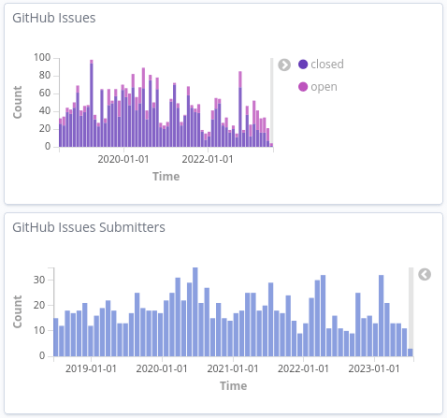In this new chapter of the Metric of the Month, we delve into an important topic: measuring the value of Open Source Program Offices (OSPOs) with project awareness and popularity metrics.
As the adoption and significance of open source software continue to grow, organizations realize the need to establish dedicated teams and processes to manage their open source initiatives effectively. OSPOs facilitate open source adoption, ensure compliance, and foster community engagement.
However, metrics become essential to assess the effectiveness of OSPOs and demonstrate their value. In this blog post, we will explore the metrics that can help measure the impact and value of your open source community, enabling OSPOs to make informed decisions and optimize their open source strategies.
The 5 metrics Bitergia suggests to measure the success of your community
In open source software, technical excellence alone is insufficient for project success. Open source projects heavily rely on community support, engagement, and popularity among developers, users, and potential contributors. While building a vibrant community around your project can be challenging, leveraging the right metrics can help to significantly enhance project awareness and increase its popularity.
These metrics can help you manage your project to gain traction, attracting contributors, and fostering a thriving community. Let’s dive into 5 metrics we use in Bitergia to measure communities’ value (and, why not, success).
Forks
Forks represent the number of times another developer or organization has duplicated a project to create a separate, independent copy. While forking doesn’t necessarily guarantee project success, it indicates interest and engagement within the community. Plain users don’t fork; developers do. Contributors engage less frequently than plain users. Many forks signify that developers find value in your project and are willing to contribute to its growth and development. Forks anticipate contributors. Here is a Dashboard visualization example of Forks, at the GrimoireLab Sigils Panels.

New Contributors
The number of new contributors joining your project is crucial for measuring project popularity and community growth. It reflects the ability of your project to attract fresh talent and retain existing contributors. Tracking the number of new contributors can help you assess the effectiveness of onboarding processes, documentation, and community engagement efforts. Encouraging and supporting new contributors is vital for your project’s long-term sustainability and success. Example visualization of the Attraction and Retention dashboard, in the public https://chaoss.biterg.io:

External Change Requests
Change requests, also known as pull requests or merge requests, are a fundamental metric that demonstrates how engaged and active your community is. They represent proposed changes or additions to the project’s codebase made by external contributors. The number and quality of change requests reflect the level of interest and involvement from developers outside the core team. A healthy stream of change requests indicates that your project is seen as valuable and actively utilized by others.

New Issues
The number of new issues opened in your project’s issue tracker is essential for measuring project awareness. It signifies that users and developers interact with your project, identify bugs, suggest improvements, or seek assistance. Tracking the number of new issues can help you gauge user engagement and make informed decisions about prioritizing bug fixes and feature enhancements.

Organizational Diversity
Open source projects benefit significantly from organizational diversity, which refers to the number of distinct organizations contributing to the project. This metric highlights the level of interest and involvement from various companies, institutions, or foundations. A diverse range of contributors signifies a broad community base and reduces the risk of over-reliance on a single entity.
To foster organizational diversity, it’s crucial to actively engage with companies and promote the benefits of contributing to your project. This is usually a task for the ISPOs (InnerSource Program Offices), and the metric reflects their success.

Unveiling the Full Spectrum of OSPO Metrics!
While we’ve explored a handful of essential metrics in this blog post, a treasure trove of insightful metrics is waiting to be discovered. We are thrilled to dive deeper into the world of Open Source Program Offices (OSPOs) and unveil many metrics that will empower you to measure their value across various aspects.
Take advantage of the opportunity to understand OSPO metrics and revolutionize your open source strategies comprehensively. Discover captivating insights about their value, implementation strategies, and how they can be leveraged in different organizations.
Stay tuned for our upcoming chapters in the Metric of the Month series, where we will unlock the secrets of OSPOs’ true potential. Follow the Metric of the Month series on this exhilarating journey.
Get ready for a fascinating exploration that will shape the future of your open source initiatives!









